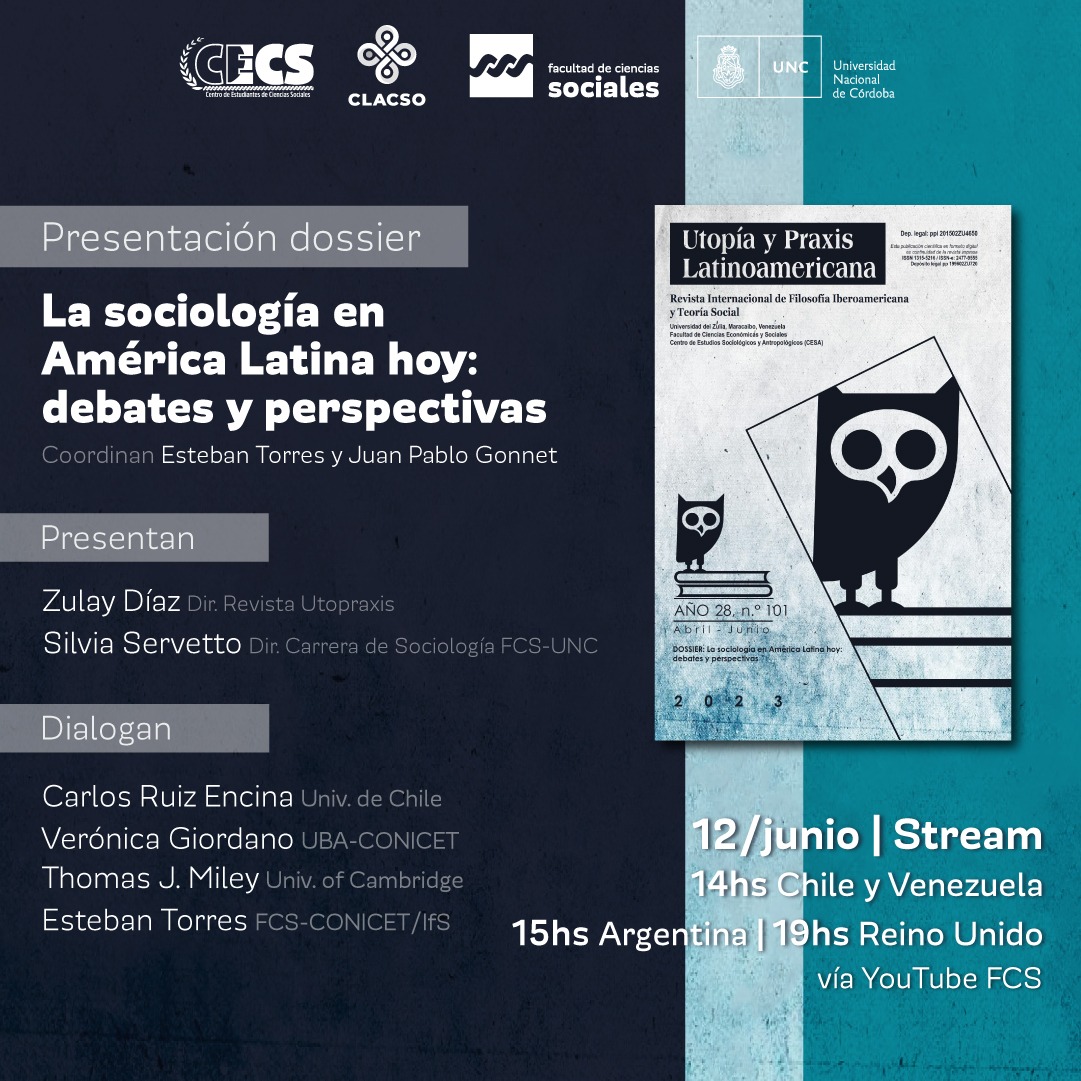El futuro del Antropoceno / The Future of the Anthropocene
Resumen
RESUMEN:
La controversia por el Antropoceno ha activado cuatro tipos de discusiones: i) si hay indicadores geológicos o no para identificarlo; ii) cuándo comenzó; iii) si lo denominamos antropoceno, capitaloceno, tecnoceno, plantacionoceno o chthuluceno; y iv) si es una discusión científica o política y de la "cultura popular." Más allá de una competencia originaria atribuida a la geología, el debate se ha abierto a las ciencias sociales y humanidades ya que, sin duda las involucra. Este artículo parte de identificar una de las paradojas de esa controversia -pensar menos la evolución extensa del sistema tierra que identificar problemas actuales gestados en un pasado reciente que activan diversas preocupaciones a futuro- para sugerir recentramientos respecto de las cuatro discusiones
ABSTRACT:
The Anthropocene controversy has triggered four discussions: i) whether there are geological indicators or not to identify it; ii) when it started; iii) if we better define it as capitalocene, technocene, plantacionocene or chthulucene; and iv) if it is a scientific or political discussion for the "popular culture”. Beyond the original competence attributed to geology, the debate has interested the social sciences and humanities, since they are undoubtedly involved. This article starts identifying one of the paradoxes of this controversy --to think less about Earth system long term evolution, than to identify current situations arisen in a recent past that trigger diverse future concerns-- to suggest changes of focus vis-à-vis the four discussions.
Citas
Autin, W.J. & Holbrook, J.M. (2012). Is the Anthropocene an issue of stratigraphy or pop culture?, GSA Today. 22(7): pp. 60–61.
Bauer, A. & Ellis, E. (2018). The Anthropocene Divide. Obscuring Understanding of Social-Environmental Change, Current Anthropology. 59: pp.209–227.
Bauman, W. A. & Stuckrad, K. (2018). Ten Theses on Academia, Society, and the Planetary Future: A Counterpoint Manifesto. URL: https://www.counterpointknowledge.org/ten-theses-on-academia-society-and-the-planetary-future-a-counterpoint-manifesto/.
Braje, T.J. (2018). The Anthropocene as process: why we should view the state of the world through a deep historical lens, Repats. 1: pp.4-20.
Chefurka, P. (2011). Carrying capacity and overshoot: another look. URL:http://www.paulchefurka.ca/CC_Overshoot.html
Cochran, G. & Harpending, H. (2009). The 10,000 Year Explosion: How Civilization Accelerated Human Evolution. Basic Books, Nueva York.
Crutzen, P. & Stoermer, E. (2000). The Anthropocene, International Geospehere-Biosphere Programme Newsletter. 41: pp. 17-18.
Descola, P. (2005). Más allá de la naturaleza y la cultura, Etnografías Contemporáneas. 1(1): pp.93-114.
Finney, S. (2018). Comment on Bauer and Ellis, Current Anthropology. 59: p.216.
Foley, R. (1997). Humans Before Humanity. Wiley-Blackwell, Oxford.
Hall, C. et al.. (2001). The need to reintegrate natural sciences with economics, Bioscience. 51: pp.663-673.
Issberner, L. & Léna, P. (2018). Antropoceno: la problemática vital de un debate científico. El Correo de la UNESCO 2018-2. ISSN 2220-2315. Disponible en https://es.unesco.org/courier/2018-2/antropoceno-problematica-vital-debate-cientifico
Kaplan, J.P. (2018). The Importance of Reference Frame, Current Anthropology. 59: pp.217-218.
Lanata, J. L.; Briones, C. & Monjeau, A. (2017). La Controversia Antropoceno como oportunidad: una cuestión de enfoques en lugar de designaciones formales, Interciencia. 42(3): pp.186-190.
Latour, B. (2004). Politics of Nature: How to bring the Sciences into Democracy, trad. Imprenta de la Universidad de Harvard, Harvard.
Latour, B. (2017). Cara a cara con el planeta. Una nueva mirada sobre el cambio climático alejada de las posiciones apocalípticas. Siglo Veintiuno, Buenos Aires.
Mauelshagen, F. (2017). Reflexiones acerca del Antropoceno, Desacatos. 54: p. 76.
Monjeau, A. et al.. (2015). ¿Sustentabilidad?, RedBioética UNESCO. 6(11):pp. 4-19.
Moore, J. (2017). The Capitalocene Part I: On the nature and origins of our ecological crisis, The Journal of Peasant Studies. 44(3):pp. 594-630.
Nudler, O. (2009). Espacios Controversiales. Hacia un Modelo de Cambio Filosófico y Científico. Miño y Dávila, Buenos Aires.
Odum, H.T. (1980). Ambiente, Energía y Sociedad. Editorial Blume, Barcelona.
Pearce, F. (2007): With Speed and Violence: Why Scientists Fear Tipping Points in Climate Change. Beacon Press, Boston.
Ribot, J. (2018). Ontologies of occlusion in the Anthropocene, Current Anthropology. 59: p. 219.
Rull, V. (2017). The “Anthropocene”: neglects, misconceptions, and possible futures, EMBO Reports. 18(7). DOI 10.15252/embr.201744231.
Sagan, D. (2011). The Human is More Than Human: Interspecies Communities and the New ‘Facts of Life’, Cultural Anthropology Online. URL: http://www.culanth.org/fieldsights/228-the-human-is-more-than-human-interspecies-communities-and-the-new-facts-of-life.
Steffen, W. et al.. (2004). Global Change and the Earth System: A Planet Under Pressure. The IGBP Book Series. Springer-Verlag, Berlín.
Steffen, W. et al.. (2015). The trajectory of the Anthropocene: The Great Acceleration, The Anthropocene Review. 2(1): pp.81-98.
Stengers, I. (2014). La propuesta cosmopolítica, Pléyade. 14: pp.17-41.
Svampa, M. (2016). El Antropoceno, un concepto que sintetiza la crisis civilizatoria, La Izquierda Diario. URL: https://www.laizquierdadiario.com/El-Antropoceno-un-concepto-que-sintetiza-la-crisis-civilizatoria
Ulloa, A. (2017). Dinámicas ambientales y extractivas en el siglo XXI: ¿Es la época del antropoceno o del capitaloceno en América Latina?, Desacatos. 54: pp. 58-73.
Verburg, P.H. et al.. (2016). Methods and approaches to modelling the Anthropocene, Global Environmental Change. 39: pp.328–340.
Wackernagel, M. et al.. (2002). Tracking the ecological overshoot of the human economy, Proceedings of the National Academy of Sciences. 99: pp.9266–9271.
Waters, C.N. et al.. (2016). The Anthropocene is functionally and stratigraphically distinct from the Holocene, Science. 351(137): 6269 aad2622.
Waters, C.N. et al.. (2018). Global Boundary Stratotype Section and Point (GSSP) for the Anthropocene Series: Where and how to look for potential candidates, Earth-Science Reviews. 178: pp.379-429.
Zalasiewicz, J. et al.. (2017). The Working Group on the Anthropocene: Summary of evidence and interim recommendations, Anthropocene. 19: pp.55-60.
Zalasiewicz, J. et al.. (2018): The Geological and Earth System Reality of the Anthropocene. Current Anthropology 59: pp. 220-223.












